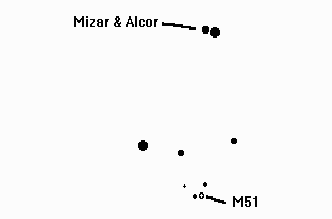Finding Some Old Friends
Jack Kramer
Whenever we're out observing, we invariably spend part of the time looking at showpieces - those particularly bright and interesting deep sky objects to which we return again and again. Instead of referring to them by their Messier or NGC numbers, many times we call them by familiar names such as "Orion", "Andromeda", "the Veil", "the Ring", or "Hercules". A few of the showpieces have become synonymous with the constellations in which they reside. Part of their attraction is that they're easy to locate, either because they're well positioned in the sky or are visible in the finder. We have their locations commited to memory. This sometimes amazes people at public star parties. They often ask, "How do you know where to find all these things?" It's all a matter of familiarity.
But there are some showpieces that aren't quite that easy to find. For example, Greg Lutes had mentioned that he can tell how good the observing conditions are by how much detail is visible in the Whirlpool Galaxy (M51). On a good night in a dark sky, spiral structure can be seen, and sometimes the bridge to the satellite galaxy. But he also noted that it takes him forever to locate it; he knows where it is, but just can't seem to pick it up right away unless the sky is sufficiently dark to catch it in the finder. I have the same problem, and many others probably do too. Part of the difficulty is that as a northern object, it's located in an area of the sky that's awkward to get at with many telescopes. As I thought about it, the same problem occurs for me when looking for the twin galaxies M81 and M82 in Ursa Major. These are two bright and well-detailed galaxies of different shape that appear in the same telescopic field. But it has always been a struggle to locate them because they're not near any bright star or within a pattern of stars that makes for easy star-hopping.
With this in mind, I set out to create and commit to memory a star-hopping route to these objects that would make it a never-fail trip. (Well, almost never!) I checked this out from my backyard because star hopping is more challenging in light-polluted skies. (However, just the opposite occurs at times; in very dark skies, the profusion of stars often increases the confusion factor.) I also made it a real test by doing this during a first quarter Moon. I followed the route using the homemade finder on my copyscope, so any halfway decent finder should work. Personally, I don't have much use for the zero-power finders, such as the Telrad, although many observers wax ecstatic over its capabilities. It gets you into a general area of the sky, but you can't star hop with it to locate anything faint or off the beaten track.
To locate the Whirlpool, I set up the following route. From the last star in the handle of the Big Dipper, move to the next fairly bright star located a bit less than two degrees to the west, then drop down to a pair of stars oriented on a NW-SE line. M51 is just to the west of the easternmost of these stars.

I've retraced this route a number of times and so far, it's been a winner.
To find M81 and M82, I begin at the NW edge of the Big Dipper's bowl and find the next bright star (23 UMaj) directly in line with the top two stars of the bowl (Alpha and Delta) and equally spaced with them. Move directly north about three degrees to a triangle of stars, then continue to a trio of stars oriented roughly in a N/S line. Center the finder on the middle of the three, and move just over a degree to the east.

In the descriptions, I've tried to avoid using a lot of star numbers or Greek letters, because few of us remember them anyway. By all means, check these patterns in your own star atlas; you may find a route that works even better for you. (Also, the above illustrations don't show all the stars in the field.) It's important to know the directions you're moving when looking through your scope. I often have a problem with this; it takes awhile to get straightened out. It's also very helpful to know the actual field of view visible through your eyepieces, although I've been able to get to the objects pretty well using just the finder. Finally, the use of these star- hopping routes requires that you remember them when you're out observing. For me, that may be the biggest hurdle of all!
Published in the May 1994 issue of the NightTimes




